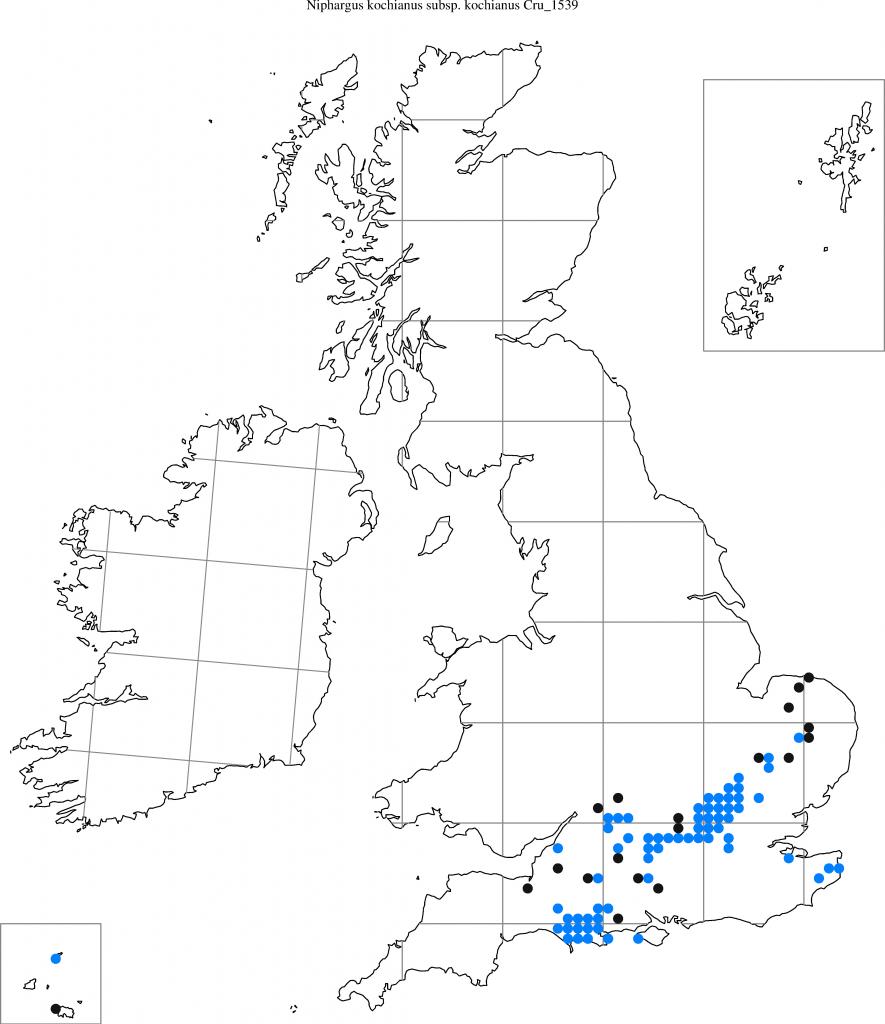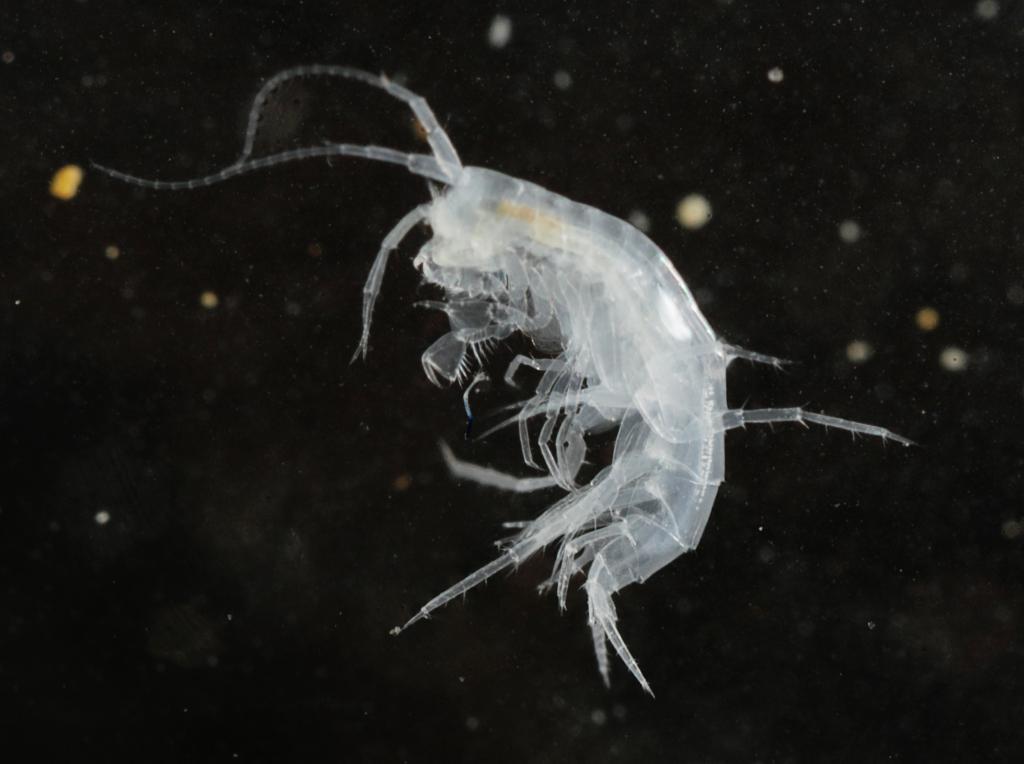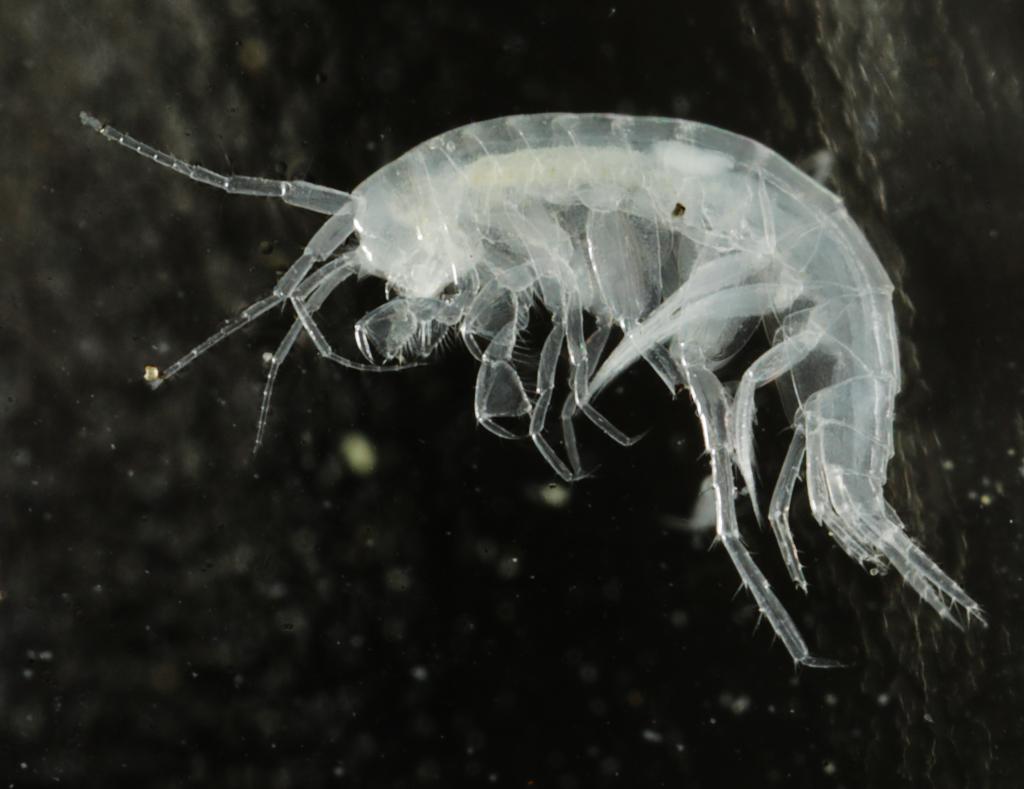First described by Bate (1859) as Niphargus kochianus from a single specimen collected from a pump in a house at Ringwood, Hampshire. In the early 1930s Schellenberg (1932; 1933) added two sub-species, one from Belgium and France and one from Ireland (Niphargus kochianus irlandicus), [formerly English N. kochianus was also described as a sub-species (cf. Niphargus kochianus kochianus) see below] upon examination of the first male specimens of the group obtained. British specimens of male Niphargus kochianus were not recorded until 1970, from the Waterston cress beds by Gledhill (1977) (although there is a dubious record of a male specimen from St. Cuthbert’s in 1966). It is thought that the hitherto rarity of records for the males was due to the dominance of females in most collections and the fact that the two sexes are very similar morphologically. Sexual dimorphism is not evident in the uropods, as it is in most niphargids, but in the length of the carpus of gnathopod 2, which is distinctly longer than the propodus in females, a key diagnostic feature for the species. Adult males are also on average smaller, about 3 to 4mm (mean 3.1mm in Stock & Gledhill, 1977)), in comparison to females which average 4 to 6mm (mean 3.9mm in Stock & Gledhill, 1977), the reverse being true for most other gammarids. Stock & Gledhill (1977) raise the interesting question as to whether the low percentage of males in certain populations and their smaller size might be due to the possibility of parthenogenesis occurring in the kochianus group, with the possibility of sex-reversal occurring in protandrous individuals.
The newly discovered British males differed from the descriptions of European male. Niphargus kochianus and it was thought that the European specimens might actually belong to a different sub-species. Stock & Gledhill (1977) revised the taxonomy of the Niphargus kochianus group in North West Europe. Specimens from the Netherlands and Belgium, previously thought to be Niphargus kochianus, were re-designated as a new sub-species, Niphargus kochianus dimorphopus, (later elevated to species rank cf. Niphargus dimorphopus), based on the pronounced secondary sexual dimorphism of the male’s second pair of gnathopods, which is feeble in N. kochianus. Another sub-species N. kochianus pachypus (south-eastern Netherlands to southern France) was also re-described and raised to species rank (cf. Niphargus pachypus ). Niphargus kochianus is also very similar morphologically to its Irish congener Niphargus irlandicus (formerly Niphargus kochianus irlandicus). However, recent genetic studies by Hänfling et al. (2008), Arnscheidt et al. (2012) and McInerney et al. (2014) have conclusively demonstrated that N. kochianus and N. irlandicus are not closely related and are quite clearly separate species (see also Niphargus irlandicus description). Stock & Gledhill (1977) and Karaman & Ruffo (1986) consider N. kochianus to be endemic to southern England, though Vonk (1988) and Ginet (1996) record it from France and specimens were recently (2012) collected from the island of Alderney in the Channel Islands, supporting this assertion. The initial results from molecular analysis of these specimens suggest that they are closely related to N. kochianus specimens from southern England (Knight et al. 2015). The Niphargus kochianus group shares many morphological similarities with the Niphargus skopljensis group of species and the whole was regarded by Stock & Gledhill (1977) as a species complex (c.f. the kochianus-skopljensis complex) The skopljensis group includes several species (N. longidactylus, N.petrosani and N. polonicus) formerly regarded as sub-species of the Niphargus kochianus group which are recorded throughout Europe, from the Netherlands to Romania and Russia.
N. kochianus is differentiated from other British niphargids by the sub-acute palmar angle of the propodus of gnathopods 1 and 2 and the acute posterodistal angle of epimeron 3. The telson lobes lack lateral spines, although 3 - 4 distal spines are present. N. kochianus and N. irlandicus primarily differ in the shape of the propodus; an extensive fringe of D-setae on the mandible palp article 3 of N. irlandicus; a single dorsal spine on either side of urosome segment 2 in N. kochianus (3 – 4 spines in N. irlandicus); and the more acute posterodistal angle on epimeron 3 in N. kochianus.
Two pictures of female Niphargus kochianus specimens from the lake in Pen Park Hole. Note the very pointed (sub-acute palmar angle) of the first segment (propodus) of the gnathopods and the very long second segment (carpus) of the second gnathopods, key features which differentiate this species from other British Niphargus (photos courtesy of Andy Lewington).
N. kochianus has been recorded across southern England, from Norfolk and Kent in the east to Gloucestershire (possibly Somerset) and Dorset in the west. It is absent from Devon and Cornwall. There is also a single record from Jersey in 1960 and specimens conforming to the described morphology for the species were collected from Alderney in early 2012. There appears to be a strong correlation between the chalk (Cretaceous Limestone) outcrops and the distribution of N. kochianus. A similar association has been reported by Vonk (1988) in France. Most of the records are from interstitial (alluvial gravels) and phreatic (boreholes and wells) sites with only three records from caves. The single 1966 record from St. Cuthbert’s Swallet, in the Mendips is thought to be a possible confusion with mis-identified Niphargus fontanus. There are two 1951 records from Holwell Cave in the Quantock Hills of Somerset, although recent visits have only found Niphargus aquilex. Niphargus kochianus is present in large numbers, sometimes accompanied by N. fontanus, in the lake in Pen Park Hole, Bristol. This has been confirmed by recent surveys (Knight, 2017). The lake is believed to connect to the phreatic water table and the level has been observed to fluctuate with groundwater levels. It is thought that N. kochianus is predominately an inhabitant of phreatic groundwater.


